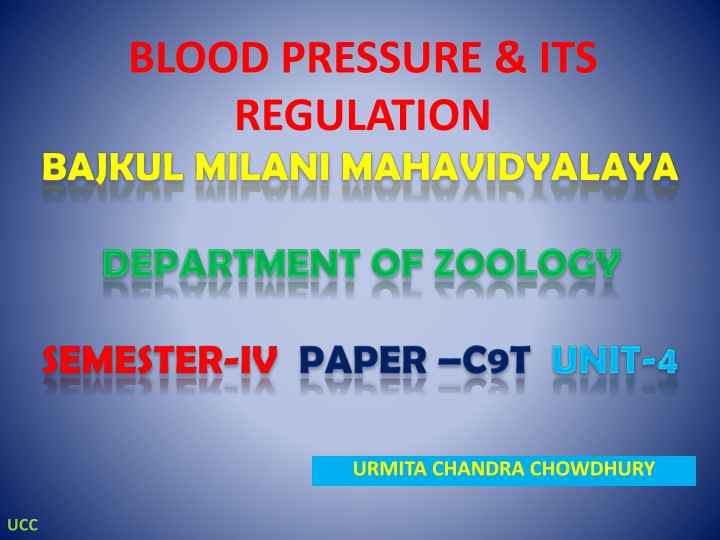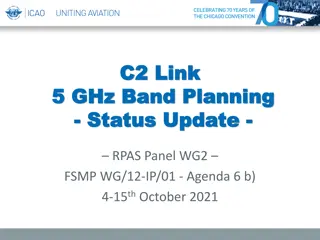
Blood Pressure and Its Regulation for Optimal Health
Explore the significance of blood pressure, its normal values, and how it is regulated in the body. Learn about arterial pressure, pulse pressure, mean arterial pressure, and their importance in maintaining overall health and well-being.
Download Presentation

Please find below an Image/Link to download the presentation.
The content on the website is provided AS IS for your information and personal use only. It may not be sold, licensed, or shared on other websites without obtaining consent from the author. If you encounter any issues during the download, it is possible that the publisher has removed the file from their server.
You are allowed to download the files provided on this website for personal or commercial use, subject to the condition that they are used lawfully. All files are the property of their respective owners.
The content on the website is provided AS IS for your information and personal use only. It may not be sold, licensed, or shared on other websites without obtaining consent from the author.
E N D
Presentation Transcript
BLOOD PRESSURE & ITS REGULATION URMITA CHANDRA CHOWDHURY UCC
BLOOD PRESSURE Arterial blood pressure can be defined as the lateral pressure exerted by the moving column of blood on the walls of the arteries. measured as mmHg. Changes in pressure are the driving force that moves blood through the circulatory system. UCC
SIGNIFICANCE To ensure the blood flow to various organs. Plays an important role in exchange of nutrients and gases across the capillaries. Required to form urine. Required for the formation of the lymph. UCC
NORMAL VALUES Normal Adult range Can fluctuate within a wide range and still be normal Systolic/diastolic 100/60 - 140/80 UCC
Arterial blood pressure rises and falls according to cardiac cycle phases. The maximum pressure during ventricular contraction is called the systolic pressure. Normal range (90-140 mm Hg). The lowest pressure that remains in the arteries before the next ventricular contraction is called the diastolic pressure. Normal range (60 -90 mm Hg). UCC
Pulse pressure is a measure of the strength of the pressure wave. Denotes the difference between systolic and diastolic pressure. Systolic pressure - diastolic pressure = Pulse pressure For example, in the aorta: 120 mm Hg 80 mm Hg =40 mm Hg pressure UCC
Mean arterial pressure is estimated as diastolic pressure plus one-third of pulse pressure. Mean arterial pressure is closer to diastolic pressure than to systolic pressure because diastole lasts twice as long as systole. MAP = diastolic P + 1/3( systolic P diastolic P ) For a person whose systolic P is 120 & diastolic P is 80: MAP =80 mm Hg + 1/3 ( 120 -80 mm Hg ) = 93 mm Hg UCC
Mean arterial pressure (MAP) is a function of cardiac output and resistance in the arterioles (peripheral resistance). BP = Cardiac output PR The cardiac output is defined as the volume discharged from the ventricle per minute. Peripheral resistance defined as the resistance to flow offered by the arterioles UCC
FACTORS MAINTAINING BLOOD PRESSURE Cardiac output (CO= SV X PR) Circulating blood volume (This mainly affects systolic B.P) Elasticity of the vessel wall Peripheral resistance. UCC
RECORDING OF BLOOD PRESSURE Palpatory method Auscultatory method PALPATORY METHOD which records the pressure at which the subject feels the first pulse in the artery. The detected pressure is systolic pressure. UCC
AUSCULTATORY METHOD in which the researcher detects the pulse by listening via a stethoscope placed in the antecubital fossa over the brachial artery. When the cuff pressure is higher than the systolic pressure, no sound is to be heard. The pressure at w hich the first sound is heard is the systolic pressure, at which the blood flow resumes and is turbulent. As the cuff pressure continues to drop, the sound becomes muffler and finally disappears. The pressure at which the sound disappears was the considered the diastolic pressure UCC
PRINCIPLE INVOLVED IN RECORDING BLOOD PRESSURE UCC
HYPERTENSION: High blood pressure, clinically diagnosed when above 140/90 mmHg. HYPOTENSION: Low blood pressure, clinically diagnosed when below 100/60 mmHg. UCC
REGULATION OF BLOOD PRESSURE UCC
REGULATION OF BLOOD PRESSURE NEURAL REGULATION Achieved through the role of cardiovascular centers located in the medulla oblongata and baroreceptor stimulation This cluster of neurons responds to changes in blood pressure as well as blood concentrations of oxygen, carbon dioxide, and other factors such as pH. Baroreceptor: A nerve ending that is sensitive to changes in blood pressure. UCC
CARDIAC CENTER Autonomic control of heart CARDIO ACCELATORY CENTRE SYMPATHETIC CARDIO INHIBITORY CENTRE PARASYMPATHETIC UCC
VASOMOTOR CENTER Autonomic control of blood vessels Stimulation of vasomotor center:VASOCONSTICTION Inhibition of vasomotor center: VASODILATION UCC
BARORECEPTOR FUNCTION Receptors located within thin areas of blood vessels and heart chambers that respond to the degree of stretch caused by the presence of blood. Send impulses to the cardiovascular center to regulate blood pressure. Vascular baroreceptors are found primarily in sinuses (small cavities) within the aorta and carotid arteries. The aortic sinuses are found in the walls of the ascending aorta just superior to the aortic valve, whereas the carotid sinuses are located in the base of the internal carotid arteries UCC
CHEMICAL REGULATION Dilation or constriction of the blood vessels by vasodilators and vasocontrictors. UCC
HORMONAL REGULATION EPINEPHRINE NOR EPINEPHRINE UCC
MECHANISMS & CONSEQUENCES OF ANP RELEASE UCC
ANTIDIURETIC HORMONE: VASOPRESSIN Increased release by posterior pituitary gland in response to decreased blood pressure and decreased blood volume. Promotes water reabsorption by kidneys Vasoconstriction of vessels UCC
RENAL REGULATION UCC




